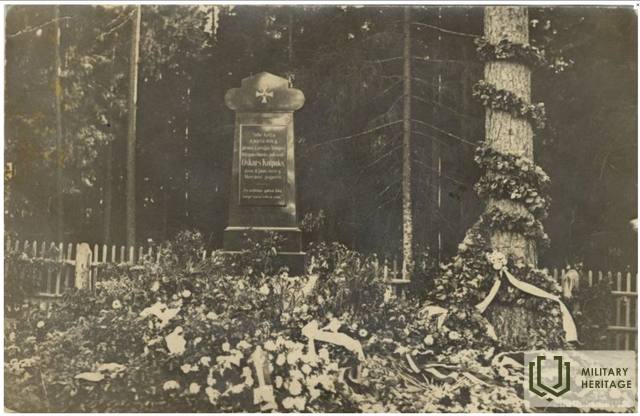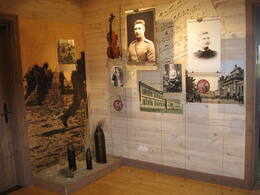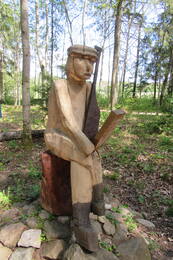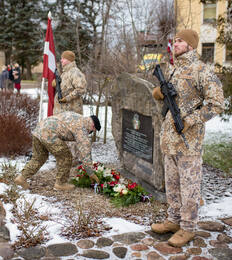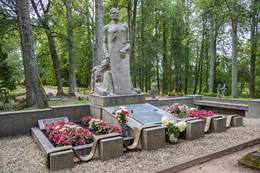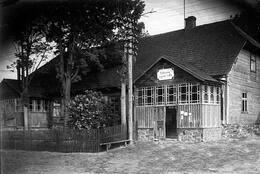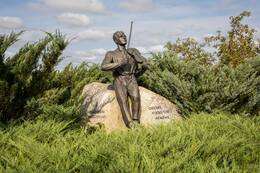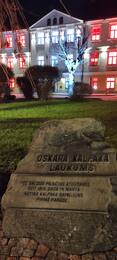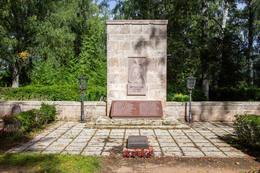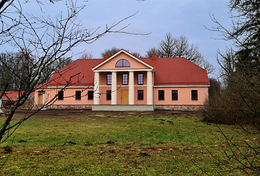Colonel Kalpak's last battle near Airīte
Colonel Kalpaks was a respected figure in military circles and a true patriot. It was the spirit of patriotism and an unfortunate coincidence that led to the fatal clash between him and the German battalions, which unfortunately ended with the death of Colonel Kalpaks.
Contemporaries described Kalpaku as a hardened and strong man in battle, who easily coped with all the difficulties of the soldiers' lives, and at the same time was a simple and sincere, kind person. General Ridiger von der Golz, who had arrived in Kurzeme from Germany, was surprised by the simplicity of Kalpak's life, but at the same time admitted that the colonel had had a cunning stance during both meetings and talks. Golcs opposed the increase in the number of Latvian forces, which Kalpaks naturally wanted, because the Germans had their own vision and other plans for Kurzeme, and possibly even for Latvia as a whole. Kalpaks, on the other hand, was thinking of winning national independence, and although the talks were conducted in a spirit of understanding, the interests of both were diametrically opposed.
On March 6, 1919, a tragic event took place near Airīte - an accidental shooting between Latvian and German units, as if a misunderstanding, as a result of which Colonel Kalpaks, Captain Nikolajs Grundmanis, Lieutenant Pēteris Krievs and Lt. An experienced battle eyewitness told him that a real fire of hell had broken out in the forest, cannon grenades had exploded, heavy minesweepers, flocks of bullets had flown.
In 1922, a monument dedicated to Oskars Kalpaks was unveiled in Airīte with funds donated voluntarily, later a house was built for the museum and an exposition about the Kalpaks Battalion and the course of its battles was placed there. The museum was opened on September 6, 1936, but was liquidated after World War II. The museum resumed its work on November 11, 1990 and is now managed by the Latvian War Museum.
Source - book "100 stories about Lavia"
Related topics
Related objects
Oskars Kalpaks Museum and Memorial Site “Airītes”
The Oskars Kalpaks Museum and Memorial Site Airītes is located between Saldus and Skrunda near the A9 highway. The exhibit has extensive information about Colonel Oskars Kalpaks and his battalion, and shows the history of the Latvian National Army and the memorial site Airītes. The exhibit reveals Colonel Oskars Kalpaks as a personality, as a soldier and as a fighter for Latvia's independence. Audio logs in Latvian, English and German are also available as part of the exhibit. They emphasize the importance of the historic events of 1918/1919 in the protecting the statehood of Latvia. The museum building has been restored.
Entry is free; guided tour – for a fee. The complex has a recreation area, a park, an obstacle course, it is possible to take various classes, and there is a seminar hall for up to 30 people.
"Nature - Strength Trail" of Oskars Kalpaks Museum
The nature trail was created in the territory adjacent to the museum and is based on the idea of the design of the O. Kalpaks Museum and its surroundings in 1936.The nature trail is free of charge for individual museum visitors.
The nature trail features wooden sculptures created during a woodworkers' plein-air workshop organised by the Kuldīga Technology and Tourism Technical School on the unifying theme - "For the Love of Freedom". Also on display are large-format paintings from the plein-air "Guard your Fatherland!" artworks painted by teams of schoolchildren from the surrounding regions.
A mini-air-track has also been created in the nature trail for the youngest visitors of the museum.
Battle of Skrunda Memorial and Flag Day
The Skrunda Battle Memorial is located in the centre of Skrunda, in Oskaras Kalpaka Park near the Skrunda Culture House, at the intersection of Kuldīgas and Liepājas Streets. In 2005, a stone was erected at the memorial commemorating the battle of 29 January 1919, when the battalion commanded by Oskars Kalpaks, together with the German and Russian units of the Landeswehr, liberated Skrunda from the Bolsheviks. The tradition of Flag Day has been maintained since 2004, commemorating the first town liberated from the Bolsheviks and its liberators, who raised the Latvian flag at the Skrunda church on 29 January 1919.
During the first months of the War of Independence, the Latvian Provisional Government, under pressure from the Bolsheviks, was rapidly losing territory. On 22 January 1919, the Bolsheviks captured Skrunda. A week later, in the early hours of 29 January, the offensive to recapture Skrunda began. The Latvian Separate Battalion under Lieutenant Colonel Oskars Kalpaks was to attack along the Rudbāržu-Skrunda highway and drive the Bolsheviks out of Skrunda. This would be followed by a flank attack by German units with the task of destroying the advancing enemy, while the Russian company would attack between the Latvian and German units, using the Skrunda church as a landmark. The attack was also supported by a German artillery battery. On the day of the attack, the frost was 15 degrees, the sun shone brightly, the Kalpaks had to cross a clear field, and the Bolsheviks were sheltering in the stone buildings of the manor. The Bolsheviks opened fire when the chain of attackers was about 300 metres away, a two-way firefight broke out, and the soldiers under Oskars Kalpaks' command advanced in a rapid advance, forcing the enemy to cease fire and retreat across the Venta. After about 3 hours of fighting, Skrunda was captured at about 9am, with the Latvian Separate Battalion having only 2 wounded.
The Battle of Skrunda was of great importance for the morale of the Latvian Provisional Government's armed Spek soldiers, as it was in fact the first significant victory in the battles against the Bolsheviks. Moreover, the commander himself, Oskars Kalpaks, showed particular courage in the battle, encouraging the soldiers by his example not to be afraid.
The last resting place of Colonel Oskars Kalpaks
Located in Visagala Cemetery, Madona district
On July 10, 1927, a monument made by Kārlis Zāle and Arnolds Dzirkaļs was unveiled to Oskars Kalpaks - a composition of three figures, in the center of which is an ancient Latvian warrior with a shield and a sword in his hand, but on both sides is a wielding soldier. At the foot of the sculptural group, a bronze plaque is placed on the granite base, with a text engraved on it, which also includes a poem by Edward Virza dedicated to Kalpak.
Oskars Kalpaks fell in 1919. On March 6, near "Airīte", on the side of Skrunda - Saldus road, on September 18, his remains were transferred from the northern cemetery of Liepāja to the family cemetery in Visagala.
The monument was unveiled by General J. Balodis, Chairman of the Monument Committee of Colonel O. Kalpaks, with the participation of the then President G. Zemgale, Prime Minister M. Skujenieks, Speaker of the Saeima P. Kalniņš, Minister of War R. Bangerskim and K. Ulmanis. The foundation stone of the monument was laid on June 19, 1925. The stone for the monument is taken from the colonel's native house in Siena swamp, O. Kalpaks loved to play the violin on this stone as a child.
Lubāna Municipality tourism and cultural heritage centre
The Lubāna Municipality Tourism and Cultural Heritage Centre is located in the very centre of the city of Lubāna. It features several exhibits, including permanent ones, on the history, culture and traditions of and events at the municipality. The permanent exhibits are dedicated to personalities that Lubāna is especially proud of. They introduce poet Broņislava Martuževa, member of the National Resistance Movement and political prisoner; politician Hugo Celmiņš, a participant of the War of Independence; Oskars Kalpaks, First Commander-in-Chief of the Latvian Army; photographer Alfreds Grāvers; opera singer Jānis Zābers; poet Jānis Gavars; artist Rūdolfs Pinnis, as well as folklorist and pastor Mārtiņš Celmiņš. A guide describes the lives of the Knights of the Lāčplēsis War Order and freedom fighters in Lubāna and its adjacent territory, as well as their resting places in Lubāna’s old graveyard. Available languages: Latvian and Russian. Guided tours with a German and English translation can be booked in advance.
The birthplace of Colonel Oskars Kalpaks “Liepsalas” and the final resting place in Visagals cemetery
The Colonel Oskars Kalpaks family memorial in Liepsalas is located in the area between Madona and Lake Lubāns. Liepsalas is Kalpaks’ childhood home. The memorial site was established here in 1997 based on the ideas and using the resources of the colonel’s niece, Ārija Kalpaks-Grundmane (1922-2006). The site consists of various environmental objects and stone sculptures with a symbolic meaning, signifying Latvian ethical and patriotic values. The largest building houses an exhibit dedicated to the history of the Latvian War of Independence and the 22 years of Latvian freedom (1918-1940). Located in the Visagals graveyard, the monument to Oskars Kalpaks, created by Kārlis Zāle and Arnolds Dzirkals, was unveiled in 1927. The monument consists of a composition of three figures, in the centre of which is an ancient Latvian warrior holding a shield and a sword, with a falling soldier on each side. Placed obliquely on a granite base, a bronze plaque at the foot of the sculptural group contains engraved text, including a poem, dedicated to Kalpaks, by Edvards Virza. Oskars Kalpaks died on 6 March 1919 near Airītes, by the road from Skrunda to Saldus.
Memorial stone in Oskaras Kalpaka Square in Saldus
O.Kalpaka Square is located in the very centre of Saldus, at the intersection of Lielā and Striķu streets.
The former market square is today a favourite place of recreation for residents and visitors of Saldus, where concerts, commemorative events and festivities are held. On 10 March 1919, Saldus became the first Latvian town liberated by Colonel Oskars Kalpaks' battalion.
On 14 March 1919, the first parade of the Latvian Separate Battalion took place in the square, and in 1992, in honour of Colonel Kalpakas, the square was named after him.
Memorial plaques to the Lubanians who died in the First World War and the War of Independence in the Lubana Lutheran Church
Located in Lubāna, Baznīcas Street 1, in the Lutheran Church.
A white marble memorial plaque to Colonel Oskars Kalpaks was erected in the church of Lubāna during the interwar period. "born Hugo Celmins.
Materials about Oskars Kalpaks and Hugo Celmiņš can be seen on a daily basis in the exposition of the Lubāna Cultural Heritage and Tourism Information Center.
Monument to the Smiltens who died in the War of Independence
Located in Smiltene Lutheran Cemetery, 11 Valnu Street.
The monument to the Smiltene victims of the War of Independence was unveiled and consecrated on November 7, 1937. The monument is built of concrete and lined with Allaži limestone slabs. The monument is based on the sketch of architect Werner Vitand and the sculptor Matiss Pluck.
In front of the monument, on October 31, 1937, the remains of the senior lieutenant, Peter Kriev, a knight of the Lāčplēsis Military Order, who had fallen in battle on March 6, 1919, were reburied from the family cemetery. On November 7, 1937, a memorial plaque of black granite was placed near his grave.
Several fallen Latvian riflemen and soldiers of the Latvian Army who fell in the War of Independence are buried in the cemetery. Smiltenes ev.lut. In the church on both sides of the altar on October 2, 1927, Dean Kārlis Kundziņš consecrated 2 white marble memorial plaques.
Lēnu Manor
The manor castle is located in the village of Lēnu, by the Venta River. The castle is currently privately owned and can therefore only be seen from a distance.
The manor house was used as a support point by the 1st Latvian Separate Battalion from the end of January to 3 March 1919. The Latvian Separate Battalion had to liberate the surroundings of Leni Manor in order to be able to cross the river opposite Jaunmuiža.
The manor belonged to Baron Friedrich von Firks, who also owned the Rudbāržzi and Sieksate manors. The manor house was built in the 19th century. For the Baron, the castle of Lēnu served mainly as a place for hunting and weekend relaxation.
From 1927 to 1937 the castle was a school, and during the Soviet occupation it was a collective farm woodshop. In 1965, a community centre was opened. The ensemble of buildings has suffered many alterations and the park has not been preserved. Several outbuildings have survived.
Oskara Kalpaka Museum military-educational task track "The Way of the Schoolboy Company"
The task track "The Way of the Schoolchildren's Company" is an attraction in the O.Kalpaks Museum territory, where there are 7 tasks of different complexity to be performed in teams (minimum number of participants per team - 3)




